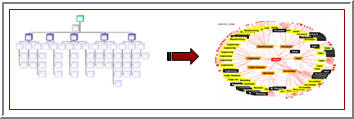| |
The problem is this: As the social, political, and economic environment grows more complex, so do—so must—our organizations. But complexity brings confusion. Today’s enterprises require far more intricate models than traditional organization charts provide. The larger the organization, the more urgent the need to see it in more complete ways. |
Which calls for new models: The “network” offers a powerful way to see the complex design and operation of our organizations. By charting the whole organization as a network, we can see each "node" in a different way. To see the network of roles, for example, we can display each position in relationship to all the rest. That way, everyone can see the same overall context from their own specific viewpoint. The same can be done from the perspective of the organization, or the location. The display of these different perspectives on networks makes it easier for people to act as parts of a coherent, flexible, adaptive system.
|
That provide new business intelligence: Network models offer objective ways to use existing corporate data. They reveal new business intelligence -- identifying hotspots, blockages, and zones of organizational confusion. This neutral, data-driven approach shows the organization from many points of view -- literally offering a new mental model. |
Without which there are risks: Without better maps, people cannot "see" where they are going or where their resources reside. When unable to portray itself from many perspectives, the enterprise is at risk. Individuals burn out, teams under-perform, and organizations veer toward collapse as stress levels rise. |
|
|

